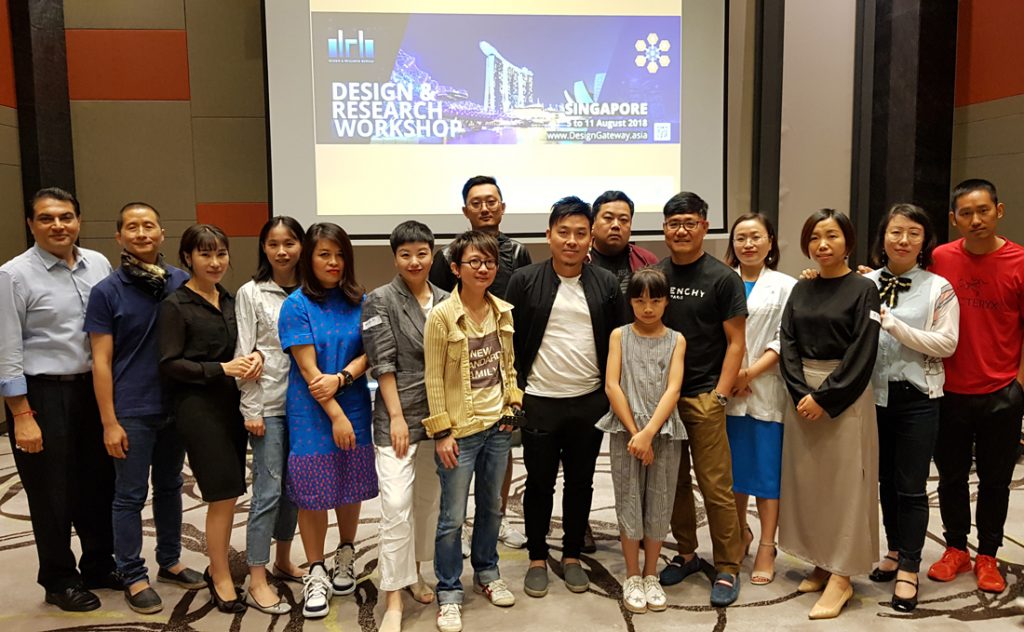Working with Design Gateway, new Singapore-based design-research group Design Research Bureau (DRB) has held its first workshop for a cohort of delegates from China.

September 14th, 2018
Interior designer Rajesh Shah is a familiar face in Singapore’s design scene via his practice as well as his involvement in the Society of Interior Designers. Keen to further his contributions to the industry, he established Design Gateway as a vehicle for the delivery of awards, seminars, workshops and events for local and overseas interior designers. Recently, Design Gateway partnered with new outfit Design Research Bureau (DRB) to deliver the first edition of ‘Design & Research Workshop’ – a means of sharing critical design thinking and research methodologies to design practitioners.

DRB was established by a group of well-known Singaporean designers: Colin Seah (Ministry of Design), Kelly Cheng (The Press Room), Peter Tay (Peter Tay Studio), Keat Ong (Nota Design Group) and Nathan Yong (Nathan Yong Design). Shah explains that the five saw the need and demand for a sharing initiative, and approached Design Gateway to facilitate the first DRB workshop on their behalf.
The first DRB workshop was a five-day event in August catering to attendees from China. The group of attendees consisted of designers and employees of companies related to the design industry, such as material suppliers. Their course, delivered by the DRB founders, consisted of three days of lectures and workshops, and two days of guided tours to prominent buildings in Singapore.
The decision to focus on an audience from China was based on the possibility of mutual benefit, as well as a desire to link industry practitioners from the region in line with China’s One Belt One Road (OBOR) initiative. Says Shah, “The One Belt One Road initiatve has far-reaching implications in as much as it will connect China all the way from Asia to the Middle East and even to Europe. The push by China’s central government to unite all along the path is significant.” He continues:
Friendships with Chinese counterparts are crucial for Singaporean designers, suggests Shah, offering the prospect of mutually beneficial business opportunities for all. “Singaporeans have ventured into China on their own for decades, with many success stories, and equal number of sad stories,” he says. He continues, “The key then is to build and forge friendships with our China counterparts. They still look up to the Singapore brand, but only in terms of creativitiy and professionalism. In terms of execution and resources, they have long surpassed us. Frienships can and will result in mutually beneficial business opportunites for all.”
In future, he says, the DRB workshops will also target ASEAN countries. “ASEAN is the next largest block after China and India,” says Shah, “in terms of population and the developmental growth of infrastructure and places to work, play and live.”
A searchable and comprehensive guide for specifying leading products and their suppliers
Keep up to date with the latest and greatest from our industry BFF's!

Channelling the enchanting ambience of the Caffè Greco in Rome, Budapest’s historic Gerbeaud, and Grossi Florentino in Melbourne, Ross Didier’s new collection evokes the designer’s affinity for café experience, while delivering refined seating for contemporary hospitality interiors.

Sub-Zero and Wolf’s prestigious Kitchen Design Contest (KDC) has celebrated the very best in kitchen innovation and aesthetics for three decades now. Recognising premier kitchen design professionals from around the globe, the KDC facilitates innovation, style and functionality that pushes boundaries.

Suitable for applications ranging from schools and retail outlets to computer rooms and X-ray suites, Palettone comes in two varieties and a choice of more than fifty colours.

Savage Design’s approach to understanding the relationship between design concepts and user experience, particularly with metalwork, transcends traditional boundaries, blending timeless craftsmanship with digital innovation to create enduring elegance in objects, furnishings, and door furniture.

Winners of The Social Space category in the 2023 INDE.Awards, RooMoo Design Studio has made its mark on the Shanghai’s hospitality landscape with a new restaurant design.

This design for a combined workplace and cultural space in Beijing is sensitive to place, people and culture, all expertly executed by CUN DESIGN.
The internet never sleeps! Here's the stuff you might have missed

Adaptive reuse is all the rage across the design industry, and rightly so. Here, we present a selection of articles on this most effective approach to sustainability.

Focusing on facade and green design, this pair of office blocks is designed to meet the most contemporary demands of workplace design.